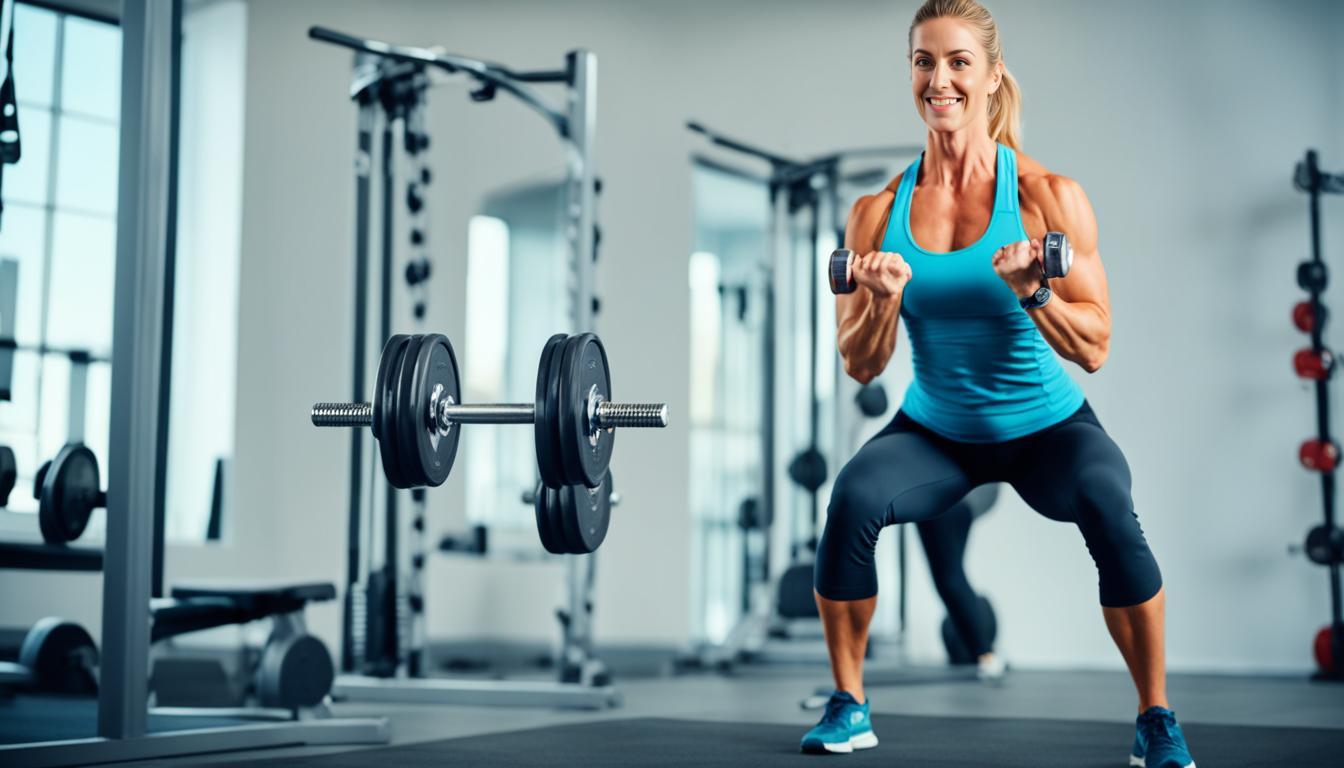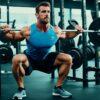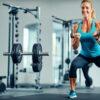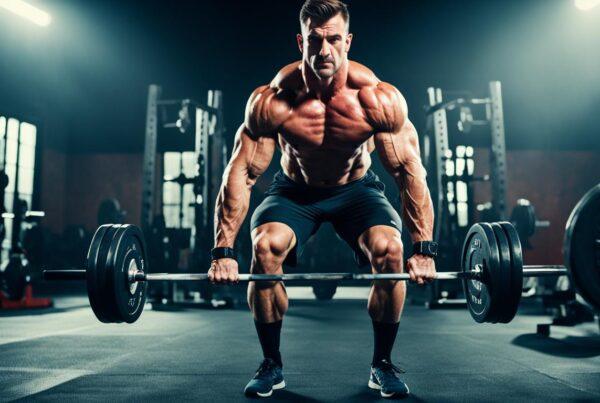Your quadriceps muscles play a crucial role in leg strength and overall lower body stability. Incorporating toning quad exercises into your workout routine is key to achieving sculpted and defined legs. These exercises not only improve muscle definition but also enhance your body’s lean muscle mass and contribute to a well-balanced physique.
By targeting your quadriceps muscles, located on the front of your legs, you can increase leg strength, improve knee stability, and decrease the risk of knee injuries. Toning quad exercises engage your quadriceps tendons and help build strength, endurance, and stability in these important leg muscles.
Whether you’re a beginner or an advanced fitness enthusiast, toning quad exercises can be tailored to your fitness level and goals. From leg extensions to lunges, there is a wide variety of exercises to choose from. Incorporate these exercises into your lower body training routine and witness the transformation of your legs.
Key Takeaways:
- Toning quad exercises are essential for sculpting and defining your legs.
- These exercises improve leg strength, knee stability, and overall lower body stability.
- Toning quad exercises contribute to enhancing your body’s lean muscle mass and overall body composition.
- Whether you’re a beginner or advanced, there are toning quad exercises suitable for your fitness level.
- Incorporating these exercises consistently into your workout routine will lead to noticeable leg toning and definition.
Benefits of Toning Quad Exercises
Quad exercises offer a range of benefits that can help you achieve your fitness goals and improve your overall leg strength and stability. Here are some key advantages of incorporating quad exercises into your workout routine:
| Benefits of Quad Exercises |
|---|
| Increase Leg Strength |
| Improve Leg and Knee Stability |
| Decrease the Risk of Knee Injury |
| Improve Body Composition |
Increase Leg Strength: Quad exercises, such as squats and leg presses, target the quadriceps muscles, which are one of the largest muscle groups in the body. By consistently performing these exercises, you can effectively increase leg strength and power, allowing you to perform various activities with greater ease and efficiency.
Improve Leg and Knee Stability: Strong quadriceps muscles play a crucial role in providing stability to your legs and knees. They help support and protect the knee joint during movements that involve knee flexion, such as walking, running, and jumping. Incorporating quad exercises into your workout routine can help improve leg and knee stability, reducing the risk of injuries.
Decrease the Risk of Knee Injury: Strengthening the quadriceps tendons through quad exercises can help decrease the risk of knee injuries, such as strains and tears. By building up the strength and endurance of these tendons, you create a more stable foundation for your knees, making them less susceptible to injuries during physical activities.
Improve Body Composition: Quad exercises contribute to improving your body composition by increasing lean muscle mass and aiding in fat loss. These exercises not only strengthen and tone your quadriceps muscles but also engage other leg muscles, resulting in a more sculpted and defined appearance. Additionally, quad exercises can help burn calories, making them a valuable addition to any weight-loss program.
By including quad exercises in your workout routine, you can enhance your leg strength, improve stability in your legs and knees, decrease the risk of knee injuries, and improve your overall body composition.
Anatomy of the Quads
The quadriceps, also known as the quads, are a group of four muscles located on the front of your thigh. These muscles work together to extend your knee and play a crucial role in various lower body movements.
The four muscles that make up the quadriceps are:
- Rectus Femoris: This is the middle head of the quadriceps, originating from the hip and extending down to the patella (kneecap). It is responsible for both hip flexion and knee extension.
- Vastus Lateralis: This is the largest head of the quadriceps and is located on the outer side of the thigh. It plays a key role in knee extension.
- Vastus Medialis: This muscle is located on the inner side of the thigh, near the knee. It contributes to knee extension and provides lateral stability to the patella.
- Vastus Intermedius: This muscle is situated beneath the rectus femoris and is primarily responsible for knee extension.
Together, these muscles form a strong and powerful group that supports leg movement and stability.
How often should you work the quads?
The frequency of quad workouts depends on your goals and fitness level. Beginners, intermediate, and advanced individuals have different needs when it comes to exercising their quads.
Beginners
If you are a beginner, it is best to start slow and gradually increase your quad workout frequency. Aim to work your quads one to two times per week, allowing at least three days of rest in between each session. This rest period is crucial for adequate recovery and muscle growth. As a beginner, focus on mastering proper form and technique before increasing the intensity of your workouts.
Intermediate
Intermediate individuals who have a moderate level of fitness and experience can adjust the frequency of their quad workouts based on their goals. Depending on your personal needs, you can increase the frequency to two to three times per week. Intermediate level workouts should incorporate a combination of strength training and conditioning exercises to continue challenging your muscles and promoting progress.
Advanced
Advanced athletes and individuals with a high level of fitness can further adjust their quad workout frequency. Depending on your specific goals and training regimen, you can work your quads three to four times per week or even more. Advanced workouts often involve a variety of exercises and training techniques to continuously challenge the muscles for maximum strength and growth.
Regardless of your fitness level, it is vital to listen to your body and avoid overworking the quad muscles to prevent injuries. Consistency and proper form are the keys to achieving your goals and making progress. Incorporate quad exercises consistently into your lower body training routine to see noticeable improvements in leg strength and overall physique.
| Fitness Level | Recommended Quad Workout Frequency |
|---|---|
| Beginners | 1-2 times per week with at least 3 days of rest between sessions |
| Intermediate | 2-3 times per week |
| Advanced | 3-4 times per week or more, depending on goals and training intensity |
Warm-up for Leg Workouts
Preparing your body for intense leg workouts is crucial to maximize your performance and minimize the risk of injuries. A proper warm-up routine helps increase blood flow to the muscles, raises your core body temperature, and activates the target muscles. By incorporating specific warm-up exercises, you can optimize your leg training sessions and make the most out of your workout time.
One essential benefit of warming up is the increased blood flow to the muscles. It helps deliver oxygen and nutrients to the working muscles, preparing them for the upcoming exercise. This enhanced blood flow also aids in the removal of metabolic waste products, such as lactic acid, which can accumulate during training and cause muscle fatigue.
Raising your core body temperature is another key aspect of a warm-up. Increased body temperature results in improved muscle elasticity, making them more responsive and less prone to strains or tears. This is especially important for leg workouts since the leg muscles are large and require adequate elasticity to handle the demands of heavy lifting or intense movements.
Activating the target muscles through warm-up exercises is crucial to ensure proper muscle recruitment and engagement during your leg workouts. By activating the leg muscles, you can enhance their responsiveness and coordination, allowing for optimal performance and better muscle development.
Consider incorporating dynamic stretching exercises, such as leg swings or walking lunges, to improve mobility and release tension in the leg muscles. Foam rolling, also known as self-myofascial release, can help alleviate muscle tightness and promote better blood flow. Additionally, using resistance bands for band walks or lateral leg raises can activate the hip muscles and enhance stability during leg exercises.
Remember, a proper warm-up routine is essential for injury prevention and optimal performance during leg workouts. By increasing blood flow, raising core body temperature, and activating the target muscles, you can maximize the benefits of your leg training sessions and achieve your fitness goals more effectively.
Beginner Workouts
If you’re new to quad workouts, starting with exercises that focus on building muscle size, conditioning, and fat loss is a great way to begin your fitness journey. These beginner quad workouts will help you develop strong, toned legs while gradually improving your strength and stability.
Here are some effective quad exercises that are perfect for beginners:
1. Leg Extensions
Leg extensions are a fantastic exercise for isolating and targeting the quadriceps muscles. This exercise primarily works the rectus femoris muscle, which is one of the four main quadriceps muscles. To perform leg extensions:
- Sit on a leg extension machine with your back against the support pad and your feet resting against the resistance pad.
- Adjust the machine’s settings to fit your comfort level, ensuring that your knees are aligned with the machine’s axis of rotation.
- Extend your legs fully, lifting the weighted pad by contracting your quadriceps.
- Pause for a moment at the top of the movement, then slowly lower the weight back down.
- Repeat for the desired number of reps.
2. Leg Press
The leg press is another effective exercise for targeting the quads, as well as engaging other lower body muscles like the glutes and hamstrings. It also provides excellent overall leg strengthening benefits. To perform the leg press:
- Position yourself in a leg press machine with your feet shoulder-width apart and your knees bent.
- Push the platform away from you by extending your legs, keeping your back against the seat and your core engaged.
- Pause for a moment when your legs are fully extended, then slowly lower the platform back to the starting position.
- Repeat for the desired number of reps.
3. Lunges
Lunges are a functional exercise that targets the quads, glutes, and hamstrings, while also improving balance and coordination. There are different variations of lunges, such as walking lunges and stationary lunges.
- Stand with your feet hip-width apart and take a big step forward with your right foot.
- Lower your body down by bending your right knee until your right thigh is parallel to the floor, making sure your knee doesn’t extend beyond your toes.
- Push off your right foot, returning to the starting position.
- Repeat the same steps with your left foot.
- Continue alternating legs for the desired number of reps.
Intermediate Workouts
Intermediate quad workouts are designed for individuals who have at least 1-2 years of consistent weight training experience. These workouts are more challenging and offer increased volume and intensity to further develop muscle size and strength. In addition to muscle growth, these workouts also incorporate conditioning and fat loss elements, helping you achieve a more sculpted physique. To maximize your progress, it’s crucial to challenge yourself with heavier weights and maintain proper form and technique throughout your training.
Examples of Intermediate Quad Workouts
| Exercise | Sets | Reps |
|---|---|---|
| Leg Press | 4 | 8-10 |
| Dumbbell Split Squats | 3 | 10-12 |
| Compound Sets: 1. Squats 2. Walking Lunges |
3 | 8-10 per exercise |
These workouts include exercises like leg press, dumbbell split squats, and compound sets. The leg press is an effective compound exercise that targets the quads, hamstrings, and glutes. Dumbbell split squats help strengthen the quads while also engaging the stabilizing muscles. Compound sets, which involve performing two exercises back-to-back without rest, provide an intense stimulus to promote muscle growth and boost calorie burn.
Remember to adjust the weights according to your strength level and gradually increase resistance over time. Always prioritize proper form and technique to prevent injuries and optimize your gains. As you progress with your intermediate quad workouts, you’ll notice improvements in muscle size, conditioning, and even fat loss, helping you achieve your fitness goals.
 Conclusion
Conclusion
Toning quad exercises are the key to achieving the strong, sculpted, and defined legs you’ve always wanted. By incorporating quad workouts into your fitness routine, you can increase leg strength, improve knee stability, and enhance your body composition.
For beginners, it’s important to start with lighter weights and higher repetitions to focus on building muscular endurance. As you progress to intermediate level, challenge yourself with heavier weights and more advanced exercises to continue developing muscle size and strength.
Remember to warm up properly before your leg workouts to activate the target muscles and prevent injuries. Pay attention to your body and avoid overworking your quads to ensure adequate recovery.
Consistency is key when it comes to toning your quads and achieving your leg goals. Stick to your workout routine and focus on maintaining proper form to maximize the effectiveness of your exercises. With dedication and determination, you can achieve the sculpted and defined legs you desire.


 Conclusion
Conclusion





